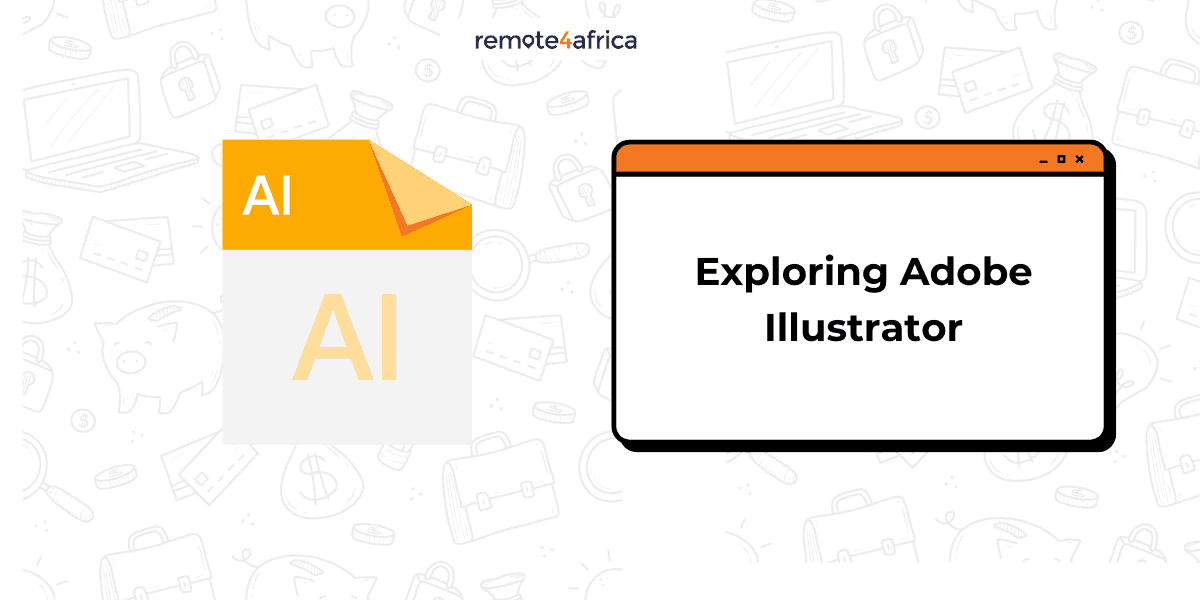Posted on Aug 19
That sums it up nicely. The ability to create detailed designs that can be scaled indefinitely without any loss of quality makes it an excellent tool for artists, logo designers, and illustrators. For a deeper understanding of its potential, take a look at this selection of features available from Adobe’s website.
In 2013, Adobe launched the Creative Cloud which marked a pivotal moment in the software's history, transitioning Illustrator from a standalone product to a cloud-based service. This shift enabled Adobe to provide regular updates, and seamless integration with other Creative Cloud applications such as Photoshop, Premiere Pro, Dreamweaver, and cloud storage options, further enhancing Illustrator's appeal to professionals and beginners alike.
Version 4, released in 1992 added preview mode for Windows, and was followed by Version 5 which added preview mode for Macintosh.
Version 6 marked the end of Macintosh-centric updates, with later versions enhancing compatibility with Windows. Version 7, introduced in 1997 added path editing and TrueType font support, and became the first to support plug-ins, expanding its capabilities.
In the early 2000s, Illustrator added web publishing features, including PDF and SVG format support. Adobe SVG Viewer was introduced in 2000 but discontinued in 2009 as native SVG support became standard. In 2003, Adobe released Illustrator CS as part of Adobe’s Creative Suite (CS) and added 3D object creation.
CS2 was released in 2005 and introduced a custom workspace, while CS3 (in 2007) added live colour and colour guide panels. CS4 was released in 2008 and introduced multiple artboards. CS5 (in 2010) brought the Blob Brush and an upgraded gradient tool, while CS6 (in 2012) featured a new interface and enhanced performance.
Illustrator transitioned to Adobe Creative Cloud (CC) after CS6 in 2013, with the latest version being Illustrator CC.
With consistent practice and the right learning resources, most users can grasp the basics relatively quickly. The key to overcoming the initial learning curve is to focus on understanding fundamental concepts such as vector paths, anchor points, and layers.
Online tutorials, courses, and Adobe’s extensive documentation can be very helpful for learners at all levels. In addition, experimenting with real-world projects, such as creating a logo or a poster, can accelerate the learning process and build confidence.
The Pen Tool
Layers
The Type Tool
Colour and Gradients
Adobe Illustrator's New AI Tools
Text-to-Vector
Retype
Vectorize
Auto-Recolour
Content-Aware Crop
Freelancing
Training and Mentoring
Adobe Illustrator could be the premium software for creative professionals with plenty of careers in design, illustration, and digital art. With its ever-evolving features, including the latest AI tools, Illustrator continues to be an indispensable asset for anyone serious about a career in design.
Exploring Adobe Illustrator: A Career Guide

From sketchy ideas to digital masterpieces, Adobe Illustrator has been the go-to tool for artists and designers everywhere. Whether you're crafting killer logos, mind-blowing illustrations, or typography that makes people do a double-take, Illustrator's got you covered as its versatility makes it an essential tool for anyone looking to build a career in design.
This guide explores the evolution of Adobe Illustrator, the essential skills needed to master it, the impact of its new AI tools, and how you can leverage your expertise to craft a successful career.
This guide explores the evolution of Adobe Illustrator, the essential skills needed to master it, the impact of its new AI tools, and how you can leverage your expertise to craft a successful career.
What is Adobe Illustrator?
Adobe calls it the “Industry-leading vector graphics software” used to create logos, web graphics, icons, drawings, typography, and complex illustrations for any medium.
That sums it up nicely. The ability to create detailed designs that can be scaled indefinitely without any loss of quality makes it an excellent tool for artists, logo designers, and illustrators. For a deeper understanding of its potential, take a look at this selection of features available from Adobe’s website.
Quick History, Evolution, and the Creative Cloud
You'll probably be surprised to learn that Adobe launched the very first version of Illustrator way back in 1987 as one of the first vector graphics editors. Since then, it has come a long way, adding new features, including the latest AI features introduced in the early 2020s. Initially developed for the Apple Macintosh, it set a new standard for graphic design software, allowing designers to create scalable graphics without losing quality, a significant advancement over pixel-based design tools.
In 2013, Adobe launched the Creative Cloud which marked a pivotal moment in the software's history, transitioning Illustrator from a standalone product to a cloud-based service. This shift enabled Adobe to provide regular updates, and seamless integration with other Creative Cloud applications such as Photoshop, Premiere Pro, Dreamweaver, and cloud storage options, further enhancing Illustrator's appeal to professionals and beginners alike.
The Illustrator Changelog
Illustrator has indeed undergone a remarkable transformation. Version 1 was released in 1987 for Apple Macintosh and initially focused on font development and printer communication via PostScript. These early versions lacked a preview mode, requiring a second window to view work. Version 2 launched in 1989 and was the first to support Windows. Subsequent versions in the early 1990s also catered to other operating systems but were discontinued due to limited market acceptance.
Version 4, released in 1992 added preview mode for Windows, and was followed by Version 5 which added preview mode for Macintosh.
Version 6 marked the end of Macintosh-centric updates, with later versions enhancing compatibility with Windows. Version 7, introduced in 1997 added path editing and TrueType font support, and became the first to support plug-ins, expanding its capabilities.
In the early 2000s, Illustrator added web publishing features, including PDF and SVG format support. Adobe SVG Viewer was introduced in 2000 but discontinued in 2009 as native SVG support became standard. In 2003, Adobe released Illustrator CS as part of Adobe’s Creative Suite (CS) and added 3D object creation.
CS2 was released in 2005 and introduced a custom workspace, while CS3 (in 2007) added live colour and colour guide panels. CS4 was released in 2008 and introduced multiple artboards. CS5 (in 2010) brought the Blob Brush and an upgraded gradient tool, while CS6 (in 2012) featured a new interface and enhanced performance.
Illustrator transitioned to Adobe Creative Cloud (CC) after CS6 in 2013, with the latest version being Illustrator CC.
Is Adobe Illustrator Hard to Learn?
Illustrator’s interface is designed for user-friendliness, making it easier for beginners to navigate and access essential tools. The toolbar is organized logically, with clear labels and icons that indicate their functions. Plus, dedicated panels for layers, colours, and more keep your workspace organized and clutter-free. This streamlined setup sets the stage for a smooth learning experience.
With consistent practice and the right learning resources, most users can grasp the basics relatively quickly. The key to overcoming the initial learning curve is to focus on understanding fundamental concepts such as vector paths, anchor points, and layers.
Online tutorials, courses, and Adobe’s extensive documentation can be very helpful for learners at all levels. In addition, experimenting with real-world projects, such as creating a logo or a poster, can accelerate the learning process and build confidence.
Developing Core Skills: Illustrator's Must-Know Features
To become proficient in Adobe Illustrator, there are some skills and basic features you must master:
The Pen Tool
This could be Illustrator’s most important tool. It allows you to create precise paths, which are the foundation of vector graphics. Mastering the tool is essential for tasks like drawing shapes, creating illustrations, and designing logos.
Layers
Layers help organize your artwork which makes it easy to manage complex projects without getting overwhelmed.
The Type Tool
This tool helps to manipulate text and apply different fonts which can elevate designs, especially in branding and print media.
Colour and Gradients
Knowing how to use Illustrator's colour tools and gradients can significantly impact the visual appeal of your work. This is key for professional-quality designs.
Adobe Illustrator's New AI Tools
In recent years, Adobe has revolutionized Illustrator with AI-powered features using Adobe Sensei to leverage machine learning, automating repetitive tasks and offering intelligent suggestions.
Text-to-Vector
Text-to-Vector Graphic enables you to generate vector graphics directly from text prompts. This feature not only accelerates the design workflow but also allows for quick experimentation and iteration, making it easier to visualize and refine ideas without needing advanced technical skills.
Retype
Retype is an AI feature that allows you to transform an outlined font in an image into an editable text. It scans both Adobe Fonts and the fonts installed on your computer to find the closest matches.
Vectorize
This AI tool converts images into vector graphics with remarkable accuracy. The AI-powered improvements make it easier to fine-tune the results and achieve cleaner, more precise vector paths.
Auto-Recolour
This tool allows you to quickly change the colour scheme of your artwork. It analyses your design and suggests colour variations that fit well together, saving you time in experimenting with different palettes.
Content-Aware Crop
Content-Aware Crop uses AI to intelligently extend or trim your artwork, maintaining the integrity of your design while fitting different formats.
Building a Career with Adobe Illustrator
Mastering Adobe Illustrator can open doors to various career opportunities in the design industry. Whether you aim to be a graphic designer, illustrator, UI/UX designer, or digital artist, proficiency in Illustrator is often a fundamental requirement.
Graphic designers use Illustrator to create logos, branding materials, posters, and more. A strong portfolio showcasing your Illustrator work can help you land roles in advertising agencies, design studios, or as a freelance designer.
Adobe Illustrator is an essential tool for creating graphics for digital advertising campaigns, illustrations, and logos for social media.
Freelancing
With platforms like Fiverr, and Remote4Africa, freelancers use Illustrator to build successful careers with the flexibility of working on diverse projects, from branding to custom illustrations, often with global clients.
Training and Mentoring
If you're an experienced Illustrator user, you can also explore teaching or mentoring opportunities like creating online courses, YouTube tutorials, or writing design-related content.
Adobe Illustrator could be the premium software for creative professionals with plenty of careers in design, illustration, and digital art. With its ever-evolving features, including the latest AI tools, Illustrator continues to be an indispensable asset for anyone serious about a career in design.
Remote Jobs for Adobe Illustrator

Lysi Digital Agency
Lead Graphics/Motion DesignerFull-Time: RemoteJob Summary:We're seeking a talented Lead Graphics Designer to join our team.
Featured
Mar 31
M
Logistics / Transport Company
Graphic Designerhybrid Lagos, Lagos, Nigeria About us:We are a team of passionate people building digital infra
Mar 28
H
Human Resource Services Company
ArtWorker (Desktop Publisher)Johannesburg, South Africa Company DescriptionWho are we?We are specialists in staffing market
Mar 25
H
Human Resource Services Company
Brand DesignerJohannesburg, South Africa Company DescriptionWho are we? We are specialists in staffing marke
Mar 25
T
IT / Telecommunication Services Company
Video Content DesignerRemote Job About Us Our software is an end-to-end digital platform for intercity transportation
Mar 23
Related Resources